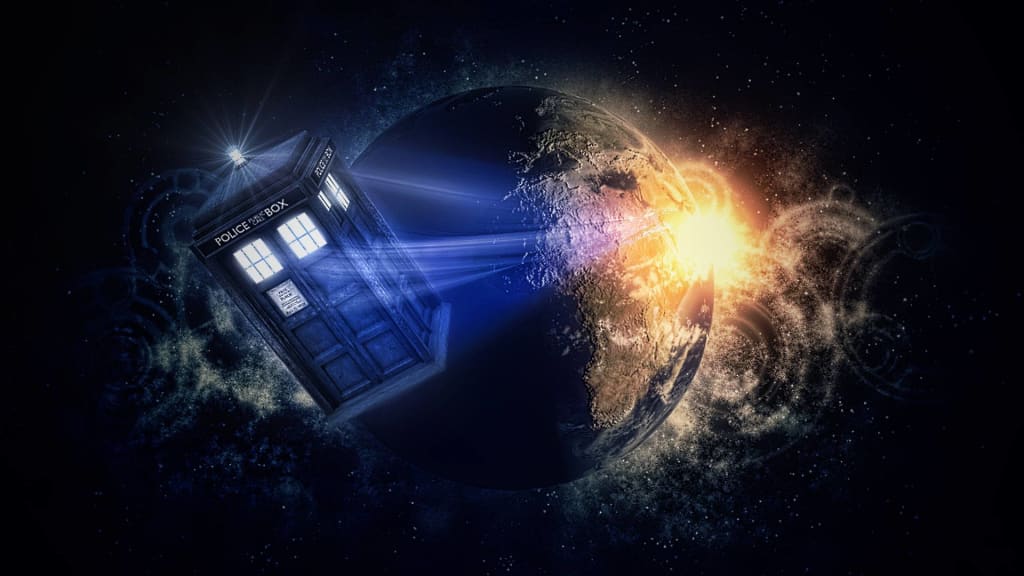Doctor Who - Rewriting History
Let's 'Re Write History'

I'm going to Re Write History here giving you a background to Doctor Who and Sci-Fi. Obviously if you're a Whovian, you'll already know this. If you're new to Doctor Who, this is important information to you! 'Listen' carefully.
Sci-FI
Sci-Fi is short for Science Fiction. Sci-Fi is a genre that will look at futuristic events. It looks at science and technology, space travel, time travel. Light travel, parallel universes and so much more.
Code and Conventions
Settings to Sci-Fi shows are either in Space, on Earth or on another planet. If it is set in space then the show is likely to have shooting/war scenes that will happen in space. If the show is set on Earth then the show will likely have enemies trying to take over the world. The protagonist of the show will aim to stop them from taking over. If the show is set on another plant then you are most likely to collide with another species. Most likely aliens. The setting of Doctor Who takes place most of the time in London. Many stories have been based in and round England’s Capital. Some stories are based in other places in England or other Countries. Some episodes you will see glimpses of space travel. Whereas some episodes are set in space itself.
Themes to Sci-Fi consist of laser shooting, space and time travel. A lot of the shooting scenes happen in space or on Earth. All of the Sci-Fi shows will have the same theme running throughout every episode. That theme is to save the world from all kinds of aliens trying to take over the world. Then the theme will continue with the protagonist coming along and battling them to stop the enemies. The theme to Doctor Who is the Doctor travelling round in space and time, saving the Earth and the Universe from all kinds of monsters and aliens. Such as Daleks, Cybermen, Autons, Ice Warriors ETC.

The Day of the Doctor
Sci-Fi shows consist of numerous characters. There will always be a protagonist to the show. The protagonist of the show will be the character trying to stop the world from being taken over by aliens. For example in Doctor Who, the Doctor himself is the antagonist. He is the one that is always saving the world. Another example of a protagonist in Doctor Who is his companion(s) that travel with him. They are always helping out the Doctor when he needs it. A perfect example of this is the episode “Flatline”. The TARDIS shrinks and the Doctor is stuck inside it. The Doctor needs Clara’s help to go and fight the monsters carrying the shrunken TARDIS in her bag. The Doctor will be telling her what to do as the episode goes along. The antagonist of the show will be the character trying to take over the world. This person/alien will usually be the leader. For example in Doctor Who, this is usually the monster/alien that appears in each story. To back this up if you look at the episode “The Unicorn and the Wasp” the alien is the Vespiform. This is a person transforming human flesh into a giant wasp going round killing people. Another example is the episode “Bad Wolf”. The antagonist in this episode is the Daleks. They are trying to take over Satellite 5 which is a games station in space.
The plot to Doctor Who changes every Series. The plot has gone from Rose Tyler (Another companion) being Bad Wolf. Bad Wolf was all over the universe in Series 1 (2005). As it progressed on, Series 8 (2014) had a plot of a mysterious character called Missy and was keeping her proper identity a secret. Her identity turned out to be one of the Doctors oldest enemies. There is still one major plot going through the Series, where is Gallifrey his home planet? We know that it is hidden away in a pocket universe, but we don't know where abouts. The Doctor is determined to find it.
Audience Profiling

John Simm as the Master
The target audience to Doctor Who is young teens upwards. Doctor Who first aired on the 23rd November 1963 at 17:16pm. From 1963 Doctor Who ran weekly episodes on a Saturday all the way up to 1989 which is when the BBC cancelled the show. These episode were roughly 25 minutes long. The programme was intended to appeal towards families as an educational programme. This was because of the use of Time Travel and how he travelled in the past to see key Historic moments that have happened in the past. Due to viewing figures rapidly dropping, the BBC decided to cancel the show in 1989.
The show was then revived in 2005 carrying on from where the show left off. In 1996 the Americans attempted a Doctor Who Movie which saw the 7th Doctor regenerate into the 8th Doctor. In 2005 we were introduced to the 9th Doctor but didn’t know where he came from. The show viewing figures then flew up in numbers as many people enjoyed it. People from 1963 are still watching it today as they enjoyed it so much in the past and are keen to see how the show will progress on. The show picks up many viewing figures as it is usually shown on a Saturday. It usually airs around 7-8pm which is Primetime TV time and will pick up many viewers. When Series 8 first aired on 23rd August 2014 it was shown right in the centre of Primetime TV. It picked up a total of 9.17 Million viewers. Due to high demands, Doctor Who is always shown on BBC One on a Saturday when a new Series begins.
Narrative Analysis

Wibbly Wobbly Timey Wimey Stuff
Doctor Who is very Multi-Stranded. The Series consists of normally 2 main character in each Series. Or even more. Each Series the Doctor will be there (obviously) with his companion. The Series will always have some focus points related to these characters. When it comes to whether it is Linear or Non Linear, it varies. A lot of the Episodes run as Linear. For example the episode “Dalek” in Series 1 has a simple storyline that runs in order of date and time. The episode doesn’t jumble up with Time Travel or Flashbacks. On the other hand the Episode “Blink” from Series 3 has the Doctor being sent back to 1969 by a Weeping Angel during the episode. At the start of the Episode, the Doctor is shown on a DVD giving a speech about these Weeping Angels in the year 1969. Half way through the episode we see that the Doctor is sent back to 1969. Towards the end is the resolution and the Doctor is back in present day.
An important quote is used in this episode to sum up the whole episode and this whole section of the article:
“People assume that time is a strict progression of cause to effect, but actually from a non-linear, non-subjective viewpoint - it's more like a big ball of Wibbly wobbly... Timey Wimey... stuff." - The 10th Doctor
Welcome To Doctor Who!
It's all Spacey-Wacey these days.
About the Creator
Lewis Jefferies
MA Media and Communication graduate from the University of Portsmouth - Massive Doctor Who Fan.






Comments
There are no comments for this story
Be the first to respond and start the conversation.